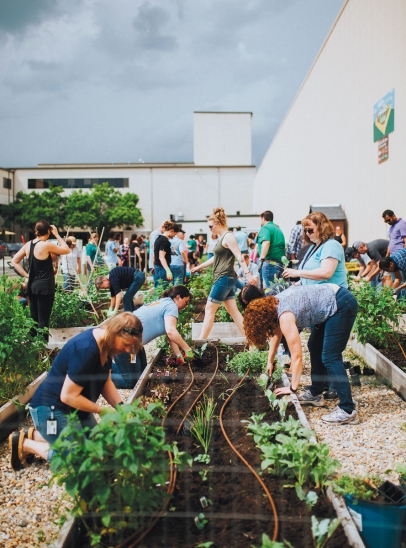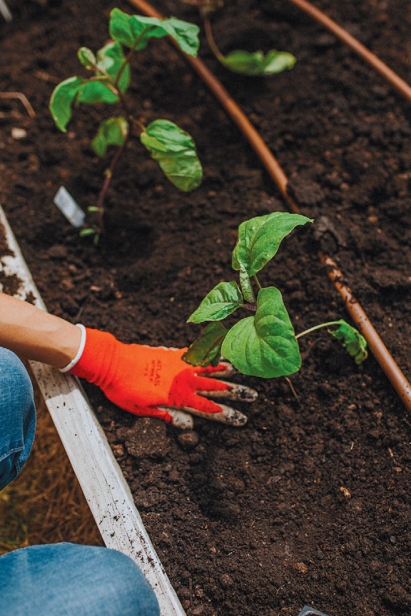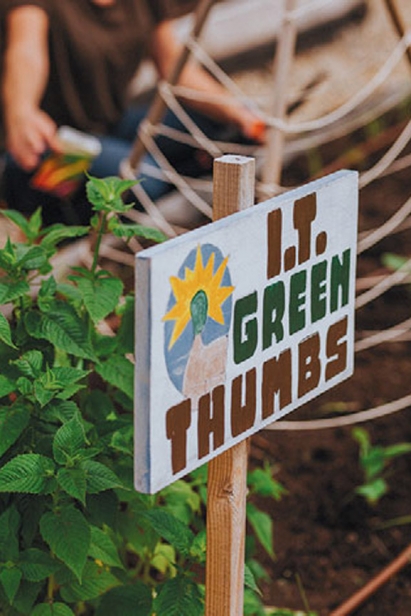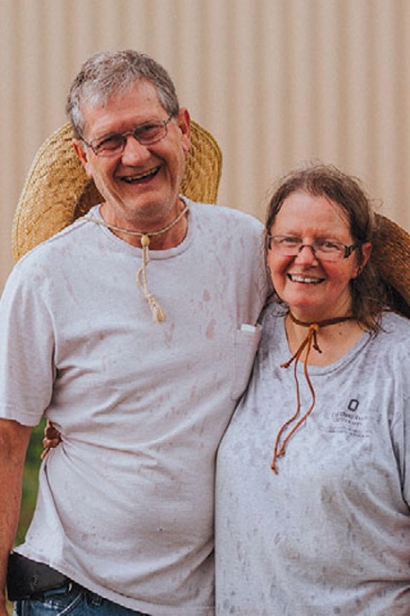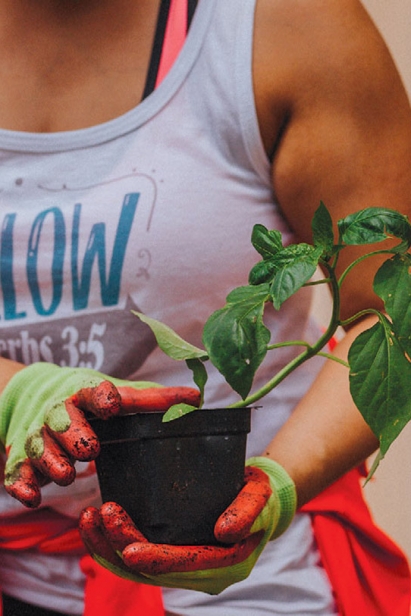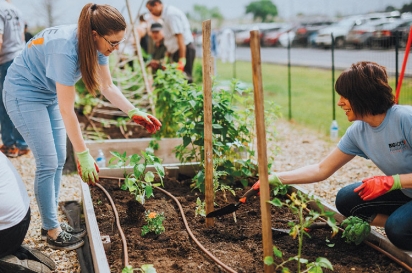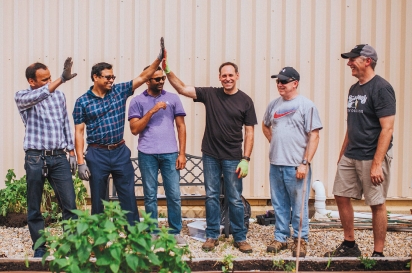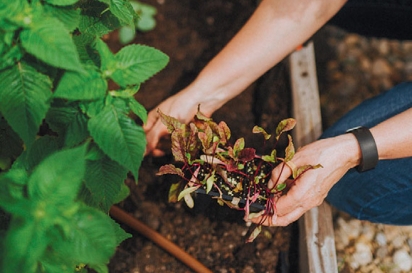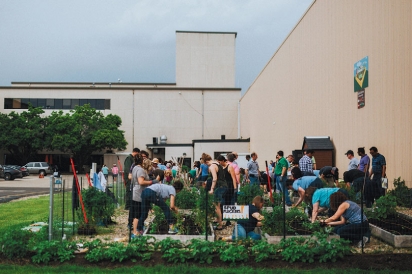Community Gardening at Big Lots’ Big Garden
The Big Lots Columbus-based national headquarters digs into community gardening
What does it take to grow a garden? Soil and water. Sunshine. The right tools. Patience. For the Big Lots’ corporate team, growing a community garden at their Columbus-based national headquarters is well worth the collective effort. With some help from master gardeners and a determined group of volunteers, the garden continues to serve both the teams that cultivate it and a local community in need.
A warm wind barrels down the side of the warehouse and through the fenced gardens alongside it, tousling young plants as Megan Mellquist and Jillian Koch, who call themselves garden co-captains, lead a walking tour between the raised beds.
“That’s yarrow,” says Megan, pointing to a tall, stalky plant with tight bundles of yellow flowers. “It keeps the bugs away.”
“This stuff that we have everywhere is bee balm. It’ll have these big vibrant pink and red flowers on it that attract the bees. It’s the big plant in every garden bed,” says Megan.
Each bed is marked with a hand-painted sign denoting the team responsible for it. “You can see this one is IT Gardens,” says Megan, pointing to one of the 18 tidy beds. Nearby a sign reads “Store Crops,” and on another, distribution and transportation services have staked claim.
“The garden pretty much touches every functional area in this company, which is great because when we get out here, people meet that sometimes have no interaction in the office,” says Megan. Time in the garden facilitates interaction through a common interest. And for a team of 800 associates at the General Office, some 175 of which volunteer in the garden, those efforts can have a noticeable impact on culture and morale.
“We coordinate a group of 10 volunteers that help manage the garden and the 175 volunteers that participate. So there’s a small group of us that coordinate all of the activities and a much larger group that volunteers on a weekly basis,” says Megan. All of the food grown is donated, shuttled in regular Friday deliveries to the Lutheran Social Services West Side Food Pantry.
After a sign-up in March, captains are chosen to coordinate various teams. Planting day, a flurry of activity among 50-plus volunteers, kicks off garden season in May.
Local partners helped to found the garden and continue to play a pivotal role in its success. DeMonye’s Greenhouse and Oakland Nursery provide plant starters at wholesale cost.
“Scotts has donated all of the soil. Some of the different companies donated the hoses and gloves. Because we have such a strong seasonal department that does lawn and garden, we have some great partners for that,” says Megan.
And then there’s Sue Simon, master gardener, planner and volunteer. In the initial planning stages Megan and Jillian contacted The Ohio State University’s extension educator and associate professor Mike Hogan.
“We reached out and right away he recommended Sue Simon as one of the gardeners to take the lead on the project,” says Megan.
Sue had worked with a number of community gardens in Central Ohio but never with a corporation.
“It was a challenge at first because I was really worried about the location, but then I thought, well, we’ll give it a shot and it worked,” says Sue. “It all kind of came together.”
Sue, along with a rotating group of additional volunteer master gardeners, make themselves available to the Big Lots team on planting and harvest days to answer questions and assist. She also creates the yearly garden plan based on what grows successfully and what recipients at the food pantry request.
“One of the major reasons I got involved,” says Sue, “is that it allows the employees to do something really good. It’s here so it gives them an opportunity to do something good for their neighbors and their community.”
“Sue comes in and helps decide what plants should go in each bed. I would have never known to plant all of the flowers and herbs together to aid pollination and keep the insects away,” says Jillian.
Sue rotates the beds and takes volunteer and extra plants to the Ohio State School for the Blind or Friends of the Homeless gardens.
“She comes out and points out, ‘This is a weed, this isn’t a weed,’ because you know, a lot of people are interested in gardening but not many have experience. A lot of people have joined because they want to know. So the master gardeners have been a huge help for us,” says Jillian.
One of the biggest challenges Megan and Jillian face is keeping engagement up throughout the year, especially during early summer months when there are more rogue weeds to pull than produce to harvest. Over the past three years they devised tactics to showcase progress and deepen connections to the community.
“We did different things to keep people engaged,” says Megan. “We have a billboard thermometer toward our goal. People got more and more involved. Then last year as we started having people deliver food directly to the food bank, that increased engagement as well because they could truly see the impact that it has,” she adds.
Every Friday during the summer, Big Lots team members drive their harvest a mile and a half down the street to Lutheran Social Services West Side Food Pantry.
“When we bring it,” Megan explains, “it’s sometimes the only fresh produce available. There are a lot of shelf-stable goods, canned goods and cereal there but most of the time it doesn’t even make it in the building. People are coming out to grab it out of the cart and rifle through,” says Megan.
It’s not just tomatoes, eggplant and other seasonal produce that the food pantry recipients seek out.
“We grow a ton of herbs in the garden in an effort to attract bees and detract the bad insects. We’ve gotten more comments about having access to fresh herbs than even some of the vegetables,” says Megan.
Across the garden, thyme plants spread low and wide, occasionally cascading off the edges of the raised beds. Peppers, tomatillos, peas and potatoes are dispersed throughout the beds this year, along with radishes, basil and squash. The team planted dozens of tomato starters that will tower by midsummer. “They’ll be this tall,” says Megan, extending her arm well above her head, “and just massive.”
Since the garden’s inception the goal has been to donate 2,000 pounds of produce to the local food bank each year. Each year the team has achieved or surpassed that goal.
“On a full harvest day when we get to early August we’ll have 10 crates lined up full,” says Megan. “We maybe do 250 pounds a week. “
After an ample August harvest there’s “just enough time for us to get something else in,” says Jillian. “We’ll grow cabbage or spinach or something that can grow quickly into the cooler weather,” she adds.
Next year the company will open a new office—and plant a new garden—in New Albany. The original property and garden will continue at the hands of dedicated team members.
“At one of the first meetings where we introduced the new office to all of the associates, one of the only questions was, ‘Will we have a garden?’ It had already been planned out,” says Megan.
The new garden will be roughly the same size as the original and will forge connections with a new community.
“We’re learning and adjusting,” says Sue. “First of all, you’ve got a great team. We have volunteers. We have money. We have soil. And we have irrigation, so there isn’t anything this garden needs,” she says, surveying the sun-drenched garden.
“We have beginners and we have really experienced farmers, so it’s fun and they get excited. They really do,” says Sue. They get excited about coming out and seeing what’s going on. They taste. It’s a lot of teamwork really. “
“It’s not just about growing vegetables,” says Sue. “It’s really about the community.”


